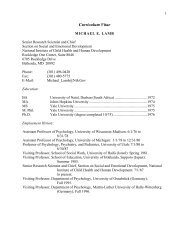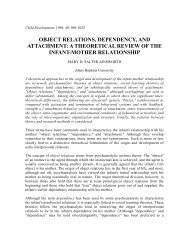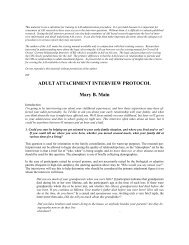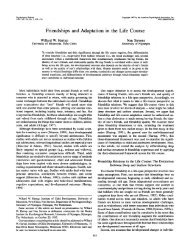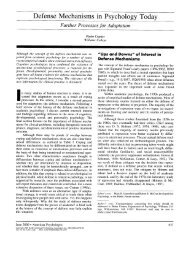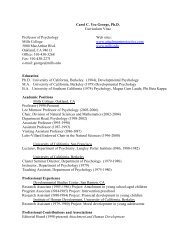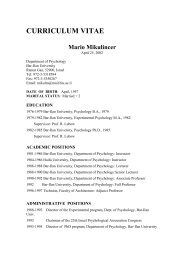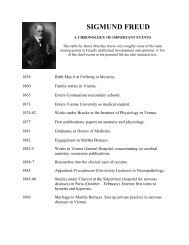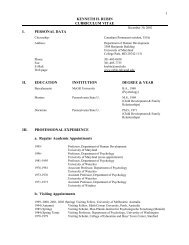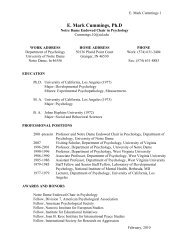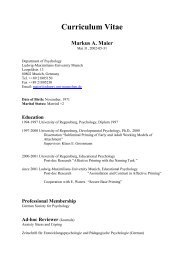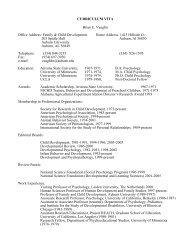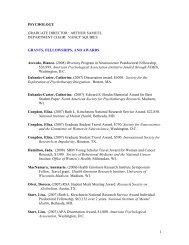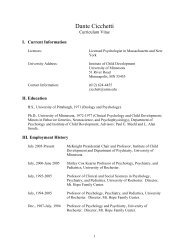the origins of attachment theory: john bowlby and mary ainsworth ...
the origins of attachment theory: john bowlby and mary ainsworth ...
the origins of attachment theory: john bowlby and mary ainsworth ...
Create successful ePaper yourself
Turn your PDF publications into a flip-book with our unique Google optimized e-Paper software.
Grief <strong>and</strong> Mourning in Infancy <strong>and</strong> Early Childhood<br />
In <strong>the</strong> third, most controversial paper, Bowlby (1960) questioned Anna Freud’s contention<br />
that bereaved infants cannot mourn because <strong>of</strong> insufficient ego development <strong>and</strong> <strong>the</strong>refore<br />
experience nothing more than brief bouts <strong>of</strong> separation anxiety if an adequate substitute caregiver<br />
is available. In contrast, Bowlby (citing Marris, 1958) claimed that grief <strong>and</strong> mourning processes<br />
in children <strong>and</strong> adults appear whenever <strong>attachment</strong> behaviors are activated but <strong>the</strong> <strong>attachment</strong><br />
figure continues to he unavailable. He also suggested that an inability to form deep relationships<br />
with o<strong>the</strong>rs may result when <strong>the</strong> succession <strong>of</strong> substitutes is too frequent.<br />
As with <strong>the</strong> first paper, this paper also drew strong objections from many members <strong>of</strong> <strong>the</strong><br />
British Psychoanalytic Society. One analyst is said to have exclaimed: “Bowlby? Give me<br />
Barrabas” (Grosskurth, 1987). Controversy also accompanied <strong>the</strong> published version <strong>of</strong> this paper<br />
in The Psychoanalytic Study <strong>of</strong> <strong>the</strong> Child. Unbeknownst to Bowlby, rejoinders had been invited<br />
from Anna Freud (1960), Max Schur (1960), <strong>and</strong> René Spitz (1960), all <strong>of</strong> whom protested<br />
various aspects <strong>of</strong> Bowlby’s revision <strong>of</strong> Freudian <strong>the</strong>ory. Spitz ended his rejoinder by saying:<br />
When submitting new <strong>the</strong>ories we should not violate <strong>the</strong> principle <strong>of</strong> parsimony in science by<br />
<strong>of</strong>fering hypo<strong>the</strong>ses which in contrast to existing <strong>the</strong>ory becloud <strong>the</strong> observational facts, are<br />
oversimplified, <strong>and</strong> make no contribution to <strong>the</strong> better underst<strong>and</strong>ing <strong>of</strong> observed phenomena.<br />
(p. 93)<br />
Despite this concerted attack, Bowlby remained a member <strong>of</strong> <strong>the</strong> British Psychoanalytic Society<br />
for <strong>the</strong> rest <strong>of</strong> his life, although he never again used it as a forum for discussing his ideas. At a<br />
meeting <strong>of</strong> <strong>the</strong> society in memory <strong>of</strong> John Bowlby, Eric Rayner (1991) expressed his regret at this<br />
turn <strong>of</strong> events:<br />
What seems wrong is when a <strong>the</strong>orist extols his own view by rubbishing o<strong>the</strong>rs; Bowlby<br />
received this treatment. . . . Our <strong>the</strong>rapeutic frame <strong>of</strong> mind is altered by <strong>the</strong>ory. John Bowlby<br />
was a great alterer <strong>of</strong> frames <strong>of</strong> mind.<br />
Bowlby’s controversial paper on mourning attracted <strong>the</strong> attention <strong>of</strong> Colin Parkes, now well<br />
known for his research on adult bereavement. Parkes saw <strong>the</strong> relevance <strong>of</strong> Bowlby’s <strong>and</strong> Robert-<br />
son’s work on mourning in infancy <strong>and</strong> childhood for gaining insight into <strong>the</strong> process <strong>of</strong> adult<br />
grief. On joining Bowlby’s research unit at <strong>the</strong> Tavistock Institute in 1962, Parkes set out to<br />
study a nonclinical group <strong>of</strong> widows in <strong>the</strong>ir homes to chart <strong>the</strong> course <strong>of</strong> nominal adult grief,<br />
about which little was known at <strong>the</strong> time, The findings led to a joint paper with Bowlby (Bowlby



